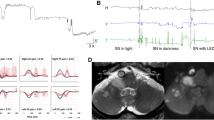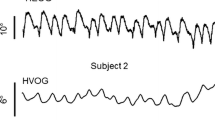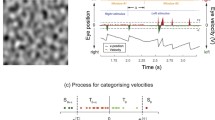Abstract
Purpose
To evaluate foveation dynamics and characteristics of vergence eye movements during fixation of static targets at different distances and while tracking a target moving in depth in a subject with congenital nystagmus (CN).
Method
Eye movements of a well-studied subject with CN were recorded using the magnetic search coil technique and analyzed using the OMtools software, including the eXpanded Nystagmus Acuity Function (NAFX).
Results
Both the phase planes and NAFX values during fixation of targets at various near distances were equivalent to those during fixation of a far target. When applied to vergence data, the NAFX values (“binocular” NAFX) were higher than for the individual eye data. Vergence tracking of targets moving in depth was demonstrated and was accurate for targets moving at speeds up to ~ 35°/sec.
Conclusions
Target foveation qualities during fixation of targets at various near distances were equivalent to that during fixation of a far target. Stereo discrimination was limited by the foveation quality of the eye with the higher NAFX waveform. Foveation period slopes during vergence tracking demonstrated vergence movements despite the ongoing CN oscillation. Similar to what we found with fixation, pursuit, and the vestibulo-ocular systems, these findings establish that vergence in both static and dynamic viewing conditions functions normally in the presence of the CN oscillation.








Similar content being viewed by others
Abbreviations
- CN:
-
Congenital nystagmus
- INS:
-
Infantile nystagmus syndrome
- IPD:
-
Interpupillary distance
- NAFX:
-
Expanded nystagmus acuity function
- JRef:
-
Jerk right with extended foveation
- PPfs:
-
Pseudo-pendular with foveating saccades
- LEH:
-
Left eye horizontal
- LEH_err:
-
Left eye horizontal error
- REH:
-
Right eye horizontal
- REH_err:
-
Right eye horizontal error
- TDIST:
-
Target distance
- TDIST_vel:
-
Target distance velocity
- TVRG:
-
Target vergence
- TVRG_vel:
-
Target vergence velocity
- VRG:
-
Vergence
- VRG_err:
-
Vergence error
- VRG_vel:
-
Vergence velocity
References
Dell’Osso LF, Van der Steen J, Steinman RM, Collewijn H (1992) Foveation dynamics in congenital nystagmus I: fixation. Doc Ophthalmol 79:1–23
Dell’Osso LF, Van der Steen J, Steinman RM, Collewijn H (1992) Foveation dynamics in congenital nystagmus II: smooth pursuit. Doc Ophthalmol 79:25–49
Dell’Osso LF, Van der Steen J, Steinman RM, Collewijn H (1992) Foveation dynamics in congenital nystagmus III: vestibulo-ocular reflex. Doc Ophthalmol 79:51–70
CEMAS_Working_Group (2001) A National Eye Institute Sponsored Workshop and Publication on The Classification of Eye Movement Abnormalities and Strabismus (CEMAS). In The National Eye Institute Publications. www.nei.nih.gov/news/statements/cemas.pdf
Collewijn H, Erkelens CJ, Steinman RM (1988) Binocular co-ordination of human horizontal saccadic eye movements. J Physiol 404:157–182
Collewijn H, Erkelens CJ, Steinman RM (1988) Binocular co-ordination of human vertical saccadic eye movements. J Physiol 404:183–197
Dell’Osso LF, Jacobs JB (2002) An expanded nystagmus acuity function: intra- and intersubject prediction of best-corrected visual acuity. Doc Ophthalmol 104:249–276
Dell’Osso LF, Gauthier G, Liberman G, Stark L (1972) Eye movement recordings as a diagnostic tool in a case of congenital nystagmus. Am J Optom Arch Am Acad Optom 49:3–13
Serra A, Dell’Osso LF, Jacobs JB, Burnstine RA (2006) Combined gaze-angle and vergence variation in infantile nystagmus: two therapies that improve the high-visual acuity field and methods to measure it. Invest Ophthalmol Vis Sci 47:2451–2460
Dell’Osso LF (1986) Evaluation of smooth pursuit in the presence of congenital nystagmus. Neuro ophthalmol 6:383–406
Erkelens CJ, Collewijn H (1985) Eye movementsand stereopsis during dichoptic viewing of moving random-dot stereograms. Vision Res 25:1689–1700
Pobuda M, Erkelens CJ (1993) The relationship betweenabsolute disparity and ocular vergence. Biol Cyber 68:221–228
Erkelens CJ, Regan D (1986) Human ocular vergence movements induced by changing size and disparity. J Physiol 379:145–169
Erkelens CJ (1987) Adaptation of ocular vergence to stimulation with large disparities. Exp Brain Res 66:507–516
Wismeijer DA, Erkelens CJ (2009) The effect of changing size on vergence is mediated by changing disparity. J Vis 9:1–10
Neveu P, Philippe M, Priot A-E, Fuchs P, Roumes C (2012) Vergence tracking: a tool to assess oculomotor performance in stereoscopic displays. J Eye Movement Res 51:1–8
Erkelens CJ, Van der Steen J, Steinman RM, Collewijn H (1989) Ocular vergence under natural conditions. I. Continuous changes of target distance along the median plane. Proc Roy Soc Lond B (Biol) 236:417–440
Erkelens CJ, Steinman RM, Collewijn H (1989) Ocular vergence under natural conditions. II. Gaze shifts between real targets differing in distance and direction. Proc Roy Soc Lond B (Biol) 236:441–465
Dell’Osso LF (2005) Using the NAFX for eye-movement fixation data analysis and display. OMLAB Report 111005:1–7
Jacobs JB, Dell’Osso LF (2010) Extending the expanded nystagmus acuity function for vertical and multiplanar data. Vision Res 50:271–278
Wang Z, Dell’Osso LF, Jacobs JB, Burnstine RA, Tomsak RL (2006) Effects of tenotomy on patients with infantile nystagmus syndrome: foveation improvement over a broadened visual field. JAAPOS 10:552–560
Wang ZI, Dell’Osso LF (2007) A review of the tenotomy nystagmus surgery: origin, mechanism, and general efficacy. Neuro-Ophthalmol 31:157–165
Regan D, Erkelens CJ, Collewijn H (1986) Necessary conditions for the perception of motion in depth. Invest Ophthalmol Vis Sci 27:584–597
Erkelens CJ, Collewijn H (1991) Control of vergence: gating among disparity imputs by voluntary target selection. Exp Brain Res 87:671–678
Erkelens CJ (2011) A dual visual-local feedback model of the vergence eye movement system. J Vision 21:1–14
Acknowledgements
This work was supported in part by the Office of Research and Development, Medical Research Service, Department of Veterans Affairs.
Author information
Authors and Affiliations
Corresponding author
Ethics declarations
Conflict of interest
The authors declare that they have no conflicts of interest.
Statement of human rights
All procedures performed in studies involving human participants were approved by the appropriate institutional committee and were in accordance with the ethical standards of the University of Maryland and with the 1964 Helsinki declaration and its later amendments or comparable ethical standards.
Statement on the welfare of animals
This article does not contain any studies with animals performed by any of the authors.
Informed consent
Informed consent was obtained from the individual participant included in the study.
Additional information
Publisher's Note
Springer Nature remains neutral with regard to jurisdictional claims in published maps and institutional affiliations.
L. F. Dell’Osso, Robert M. Steinman and Han Collewijn—Professor Emeritus
Rights and permissions
About this article
Cite this article
Dell’Osso, L.F., Van Der Steen, J., Steinman, R.M. et al. Foveation dynamics in congenital nystagmus IV: vergence. Doc Ophthalmol 140, 221–232 (2020). https://doi.org/10.1007/s10633-019-09738-y
Received:
Accepted:
Published:
Issue Date:
DOI: https://doi.org/10.1007/s10633-019-09738-y




